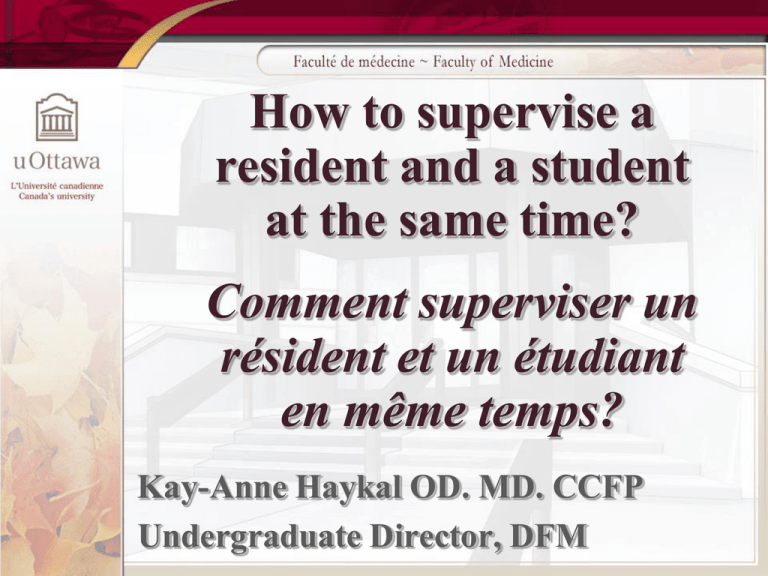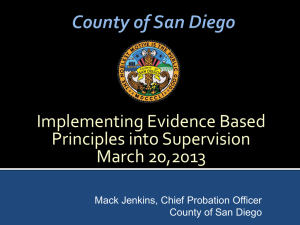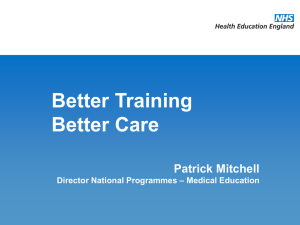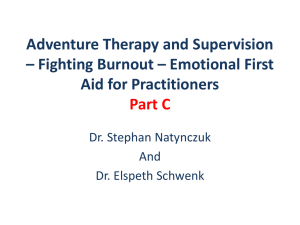this presentation
advertisement

How to supervise a resident and a student at the same time? Comment superviser un résident et un étudiant en même temps? Kay-Anne Haykal OD. MD. CCFP Undergraduate Director, DFM No conflict of interest Objectives Supervision Group supervision or supervision of multiple learners Models of supervision for students and residents Residents as teachers Supervision Understanding it Importance and effectiveness Availability Practical problems Frequency Style and structure Interest of supervisors Who should do it and how Supervision activities : what are they? Discuss individual patients Ensure patient safety Provide informal feedback Monitor the trainee’s performance Discuss the management of specific disorders Ensure that the trainee has an appropriate level and amount of clinical duties Provide feedback through appraisal Give advice relevant to personal and professional development Address successes and problems of trainee performance Give career development advice Develop team work skills Ensure the safety of trainee Discuss and review the process of supervision Teach specific techniques and procedures Plan the trainee’s learning Develop interpersonal skills Develops communication skills Develop presentation skills Beside teaching Videotaped consultations Frequency of circumstances of supervision Appraisal meeting Regular, specific meetings concerned with trainee’s progress and development Ward rounds Informally Induction meeting Tutorials “on the job” assessments During specific tasks During clinics Clinical supervision Essential at all levels of medical education Complex activity Occurs in a variety of settings Has various functions Has various modes of delivery What authors agree on supervision Should be regular Should be structured Related to learning objectives Has positive patient outcome Content should include Clinical management Interpersonal skills Personal development and reflection Barriers to taking students Increasing number of students Overloaded health care Critical placement shortages Resource constraints/space Workload pressures Quality and interest of supervisor Providing quality medical care Maintaining efficacy Time constraints Collaborative group model 2 trainees or more (2 students or 1 student and 1 resident) Take responsibility of their caseload Learners support each other Learners learn from each other They take on more responsibility Effective teamwork skills Less dependent on staff Productivity may increase Challenges of collaborative model Sharing resources Ensure enough individualised feedback Ensuring sufficient opportunities to observe trainees are competitive appropriate working relationships Staff perceives it as more time consuming but no substantial increase Multiple mentoring model A team of 2 or more learners is supervised by a team of 2 or more staff All staff share responsibility for each trainee’s education Trainees have individual case load Trainees share knowledge and problem solve together Similar benefits and challenges to collaborative group model Additional advantages Additional challenges 3 principle themes Being clear in the chaos Qualities of the service and people Is it worth it? Challenges and benefits Being clear in the chaos? Supervision can be hectic and intense Need to implement it in a carefully planned way Structure : timetables, caseloads, space and resources Communication more direct Student skills develop quickly Qualities of the services and people staff Appreciation of other’s clinical practices Work collaboratively Discuss clinical reasoning Students Develop greater awareness of their own learning skill Ability to adapt to diversity Is it worth it? The challenges and benefits Time demands and stress for both staff and students Services benefits Less experienced staff can supervise Student supervision can occur in a high turnover Increased time spent with patients students learning more More stress in the organisation of the placement and monitoring of students and patients Inconsistency among educations stressful to students Clinical teacher 4 roles Teacher role Interested in teaching Explain, discuss and answer questions Instructor as a person Supportive, easy and fun Helpful and friendly Physician role Knowledgeable and clinically competent Role model Good rapport with patients Supervisor role Gives responsibility for patient care Reviews patient with resident and student Resident’s teaching Demonstrate expertise and up-to-date knowledge Allows and encourages student participation in patient procedure Maintains a learning climate of respect and support Substantial if not more important component of medical student education Positive comments from students Residents’ availability Teaching activity Operating room teaching Commitment to teaching Concern for student learning Teaching effectiveness Role as physician and supervision did not change across their training years Residents as teachers Teachers Increase resident awareness of the importance of their role as a teacher Improve teaching behavior Residents as teachers courses Resident teaching performance Supervisors Enhance residents’ management skills Leadership skills Positive comments from residents View themselves as good teachers Feel they possess adequate teacher characteristics Attitude toward students Helps improve their clinical skills Enjoyment of working with students communication Ease of pointing out students’ deficiencies How to improve resident’s teaching Communication about their teaching responsibilities Increase participation is student programs : orientation, formal classes, clinical Provide mid-rotation feedback to students Monitor resident and student progress Encourage and support resident Conclusion Multiple learners’ teaching is beneficial for student and resident learning Benefits outweighs the challenges Need to be structured and planned Residents teaching is effective for both resident and student Residents require training and guidance to teach more effectively. Thank you Questions? References Teaching on the run: How to engage learners from different disciplines and levels of training on a busy palliative care service. El-Sourady M., Moore D., Nelson J., Misra S., Karlekar M. Journal of Pain and Symptom Management. Conference: Annual Assembly of the American Academy of Hospice and Palliative Medicine and the Hospice and Palliative Nurses Association 2014 San Diego, CA United States. Conference Start: 20140312 Conference End: 20140315. Conference Publication: (var.pagings). 47 (2) (pp 406), 2014. Date of Publication: February 2014. Supervising diverse student and trainee groups at multiple levels in high volume work environments. Brazil V., Mudge A., Toombes S. Internal Medicine Journal. Conference: RACP Future Directions in Health Congress 2012 Brisbane, QLD Australia. Conference Start: 20120506 Conference End: 20120509. Conference Publication: (var.pagings). 42 (pp 29), 2012. Date of Publication: May 2012. Priorities during ward attending rounds differ by training level of team members. Hagler B.D., Chandan P., Estrada C., Roy B., Huff N.G., Castiglioni A., Centor R. Journal of General Internal Medicine. Conference: 34th Annual Meeting of the Society of General Internal Medicine Phoenix, AZ United States. Conference Start: 20110504 Conference End: 20110507. Conference Publication: (var.pagings). 26 (pp S284), 2011. Date of Publication: May 2011. References Clinical supervision of SpRs: where does it happen, when does it happen and is it effective? Specialist registrars. Grant J. Kilminster S. Jolly B. Cottrell D. Medical Education. 37(2):140-8, 2003 Feb. What is effective supervision and how does it happen? A critical incident study. Cottrell D. Kilminster S. Jolly B. Grant J. Medical Education. 36(11):1042-9, 2002 Nov. Practice educator perspectives of multiple mentoring in diverse clinical settings. [References]. Copley, Jodie; Nelson, Alison. The British Journal of Occupational Therapy. Vol.75(10), Oct 2012, pp. 456462. AN: Peer Reviewed Journal: 2012-30914-003. Providing cross-discipline group supervision to new supervisors: Challenging some common apprehensions and myths. [References]. Cassedy, Paul; Epling, Mike; Williamson, Liz; Harvey, Gale. Cutcliffe, John R [Ed]; Hyrkas, Kristiina [Ed]; Fowler, John [Ed]. (2011). Routledge handbook of clinical supervision: Fundamental international themes. (pp. 208-217). xxvii, 404 pp. New York, NY, US: Routledge/Taylor & Francis Group; US. AN: Book: 2011-00188-019. References Effectively teaching diverse student groups : a reflection on teaching and learning strategies. Trees, Kathryn. Australian Journal of Adult Learning Volume 53 Issue 2 (July 2013) A Tiered Mentorship Program Improves Number of Students With an Identified Mentor. Kman N.E., Bernard A.W., Khandelwal S., Nagel R.W., Martin D.R. Teaching and Learning in Medicine. 25 (4) (pp 319325), 2013. Date of Publication: October 2013. Expectations and experiences of group supervision: Swedish and Norwegian preceptors' perspectives. Andersson C.S., Danielsson A., Hov R., Athlin E. Journal of Nursing Management. 21 (2) (pp 263-272), 2013. Date of Publication: March 2013. Nursing leadership from the perspective of clinical group supervision: a paradoxical practice. Bondas T. Embase Classic+Embase Journal of Nursing Management. 18 (4) (pp 477-486), 2010. Date of Publication: May 2010. Group mentoring: a transition-to-work strategy. Scott E.S., Smith S.D. Journal for nurses in staff development : JNSD : official journal of the National Nursing Staff Development Organization. 24 (5) (pp 232-238), 2008. Date of Publication: 2008 Sep-Oct. References Development and preliminary validation of a measure for assessing staff perspectives on the quality of clinical group supervision. Horton S., Drachler M.D.L., Fuller A., Leite J.C.D.C. International Journal of Language and Communication Disorders. 43 (2) (pp 126-134), 2008. Date of Publication: March 2008. Group supervision in facilitating learning and teaching in mental health clinical placements: A case example of one student group. Saarikoski M., Warne T., Aunio R., Leino-Kilpi H. Issues in Mental Health Nursing. 27 (3) (pp 273-285), 2006. Date of Publication: April 2006. Teaching to the level of the learner: The effects of a brief faculty development intervention. Zgurzynski P., Zinzuwadia S.N., Tubbs R., Woolley W., Smith J. Academic Emergency Medicine. Conference: 2011 Annual Meeting of the Society for Academic Emergency Medicine, SAEM Boston, MA United States. Conference Start: 20110601 Conference End: 20110605. Conference Publication: (var.pagings). 18 (5 SUPPL. 1) (pp S252), 2011. Date of Publication: May 2011.








